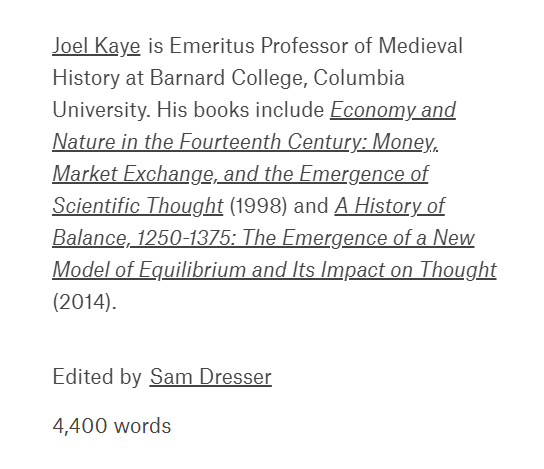Welcome to DU!
The truly grassroots left-of-center political community where regular people, not algorithms, drive the discussions and set the standards.
Join the community:
Create a free account
Support DU (and get rid of ads!):
Become a Star Member
Latest Breaking News
General Discussion
The DU Lounge
All Forums
Issue Forums
Culture Forums
Alliance Forums
Region Forums
Support Forums
Help & Search
General Discussion
Related: Editorials & Other Articles, Issue Forums, Alliance Forums, Region ForumsReimagining balance through economic equalisation

In the Middle Ages, a new sense of balance fundamentally altered our understanding of nature and society
https://aeon.co/essays/how-socioeconomic-equalisation-generates-new-ideas-of-balance


We speak today of balanced performances, balanced tastes, balanced mental states, balances of power – the balance of nature itself. In all these cases, balance holds a valence so positive that it approaches an unquestioned ideal. The sense we have of its presence or absence in large measure determines our judgment of what is right or wrong, ordered or disordered, beneficial or destructive, safe or dangerous. Its opposite, imbalance, almost invariably signals sickness and malfunction. When we stop to think about it, we can recognise the enormous breadth of meaning we attach to our sense of balance, but we might also recognise, with some surprise, just how little we actually do think about it. The same was true for the Middle Ages. Despite the central place that the ideal of balance occupied in virtually every area of medieval thought, it was almost never questioned or problematised as a topic in itself. And this raises a question: why did it, and why is it still, almost invisible as a subject of historical analysis?
I can suggest two reasons. The first is that our recognition of balance’s great importance to our psychological, intellectual and social life tends to encourage a biological and hence essentialist understanding of it. Balance is balance: we all know what we mean by it, we all trust our sense of it, we never imagine that this sense is changing, or even that it can change. For this reason, it is difficult for us to think of it in historical terms, as determined within specific cultural contexts, or as changing over time. The second, equally relevant, is that balance lies beneath the level of conscious awareness. It is tied to a generalised sense, a wordless awareness, a diffuse feeling for how things properly work together or fit together in the world, extending all the way down to our discomfort when we see a picture hanging unevenly on a wall.
For this reason, I have argued that, rather than serving as the subject of thought, balance has traditionally served as the un-worded but pervasive ground of thought, exercising its great influence beneath the surface of conscious recognition. For the historian who has become aware of balance as an historical subject in itself, the first problem, then, is how to recognise the changes that have occurred to and within this un-worded sense over historical time. The second is how to uncover and reveal the profound intellectual effects these changes have made possible. Between approximately 1250 and 1375, a manifestly new sense of what balance is, and can be, emerged. When projected onto the workings of the world, this new sense transformed the ways the workings of both nature and society could be seen, comprehended and explained. The result was a momentous break with the intellectual past, opening up striking new vistas of imaginative and speculative possibility.
The group of medieval scholars whose speculations most clearly reflected this new modelling of balance occupied the very pinnacle of their intellectual culture – brilliant innovators whose ideas stand out today for their boldness and their forward-looking elements. Indeed, the innovations these scholars pioneered, and the new sense and model of balance that made this innovation possible, provided both a first view of, and a fundamental foundation for, the emergence of modern science. I speak of ‘models of balance’ because even though the complex sense of balance remained un-worded in the pre-modern period, it was far from unstructured. These models were (and still are) composed of a cluster of interlocking assumptions, perceptions and intuitions, characterised by a high degree of interior reflectivity and internal cohesion. Within any given intellectual culture, and at any given period in history, they possess a degree of internal order and organisation sufficient to allow them to be experienced as unified wholes, which adds greatly to their potential to influence the thinking mind. Though a product of history, they are felt to be ‘natural’, which further facilitates their absorption and acceptance.
snip
InfoView thread info, including edit history
TrashPut this thread in your Trash Can (My DU » Trash Can)
BookmarkAdd this thread to your Bookmarks (My DU » Bookmarks)
0 replies, 185 views
ShareGet links to this post and/or share on social media
AlertAlert this post for a rule violation
PowersThere are no powers you can use on this post
EditCannot edit other people's posts
ReplyReply to this post
EditCannot edit other people's posts
Rec (3)
ReplyReply to this post